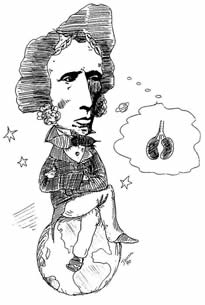
"In the Beginning, There Was a Dog Kidney"
March 1, 2006
Friedrich Wöhler (1800-1882), German chemist. A student of Leopold Gmelin at Heidelberg and of the great Berzelius at Stockholm, Wöhler held teaching positions at Berlin and Cassel before accepting the chair in chemistry at Göttingen in 1836, where he remained for the rest of his life. An eclectic chemist, he is best known in the field of organic chemistry for his collaborative work with Liebig on the isomerism of the fulminate and cyanate radicals (1823) and on the chemistry of the benzoyl radical (1832), and for his synthesis of urea from ammonium cyanate, (1828) which was later interpreted as a decisive blow against the doctrine of vitalism. In the field of inorganic chemistry, he is best known for his isolation of the elements aluminum (1827) and beryllium (1828) and, in the field of chemical education, for the many 19th-century American chemists who came to study in his laboratory.
Courtesy of Professor William Jensen, Oesper Chair of the History of Chemistry and Chemical Education, University of Cincinnati
> Past Notable Chemists